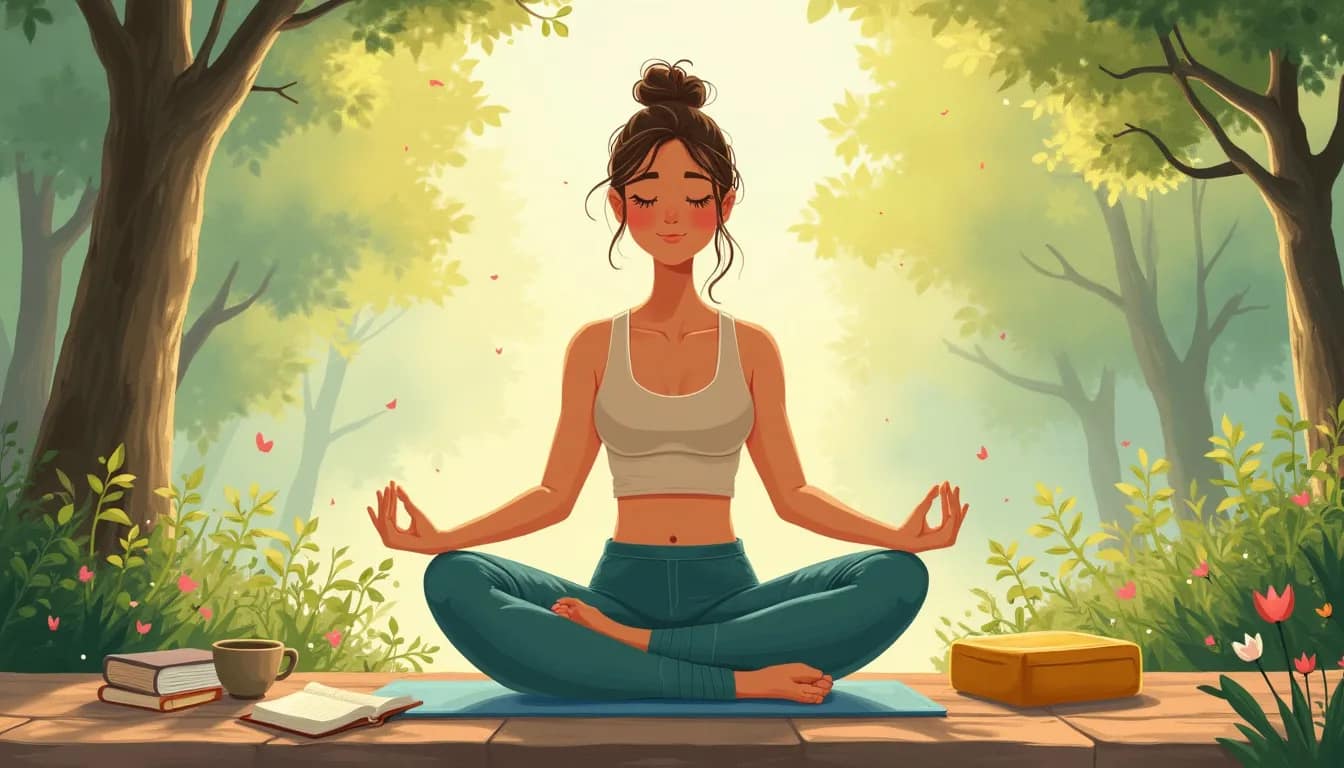In today’s fast-paced world, stress often feels like an unavoidable companion. But what if there was a simple way to invite more calm and ease into your life? Enter mindfulness—a practice that can transform stress into serenity. At its core, mindfulness involves paying full attention to the present moment and acknowledging your thoughts, feelings, and sensations without judgment. This gentle awareness can be a powerful antidote to the pressures of daily life.
Stress, a typical response to challenging situations, can significantly impact our health, leading to issues like anxiety, depression, and even physical ailments such as high blood pressure and weakened immunity. The good news is that mindfulness offers a natural and effective way to reduce stress. Practising mindfulness teaches you to navigate life’s ups and downs with more excellent poise, fostering a sense of inner peace and resilience.
This article will explore ten simple mindfulness practices that can help you reduce stress daily. These techniques are easy to integrate into your routine and benefit your mind, body, and spirit. Whether through deep breathing, mindful walking, or daily affirmations, you’ll discover accessible ways to embrace mindfulness and enhance your overall well-being. Join us on this journey to a more tranquil and balanced life.
Introduction to Mindfulness and Its Benefits for Stress Reduction
Welcome to a journey of exploring mindfulness and how it can fundamentally transform your daily experiences and help reduce stress. Though seemingly simple, mindfulness holds profound benefits that gently touch every aspect of your life, from mental clarity to physical well-being. As we delve into this realm, let’s first understand what mindfulness truly means and why it’s a powerful tool against stress.
Definition of Mindfulness
Mindfulness is the practice of intentionally focusing your attention on the present moment, accepting it without judgment. It revolves around being fully present in this very moment, anchoring your awareness to ‘now’, rather than drifting into the past or future. This simple yet potent practice fosters an environment where you can observe your thoughts and feelings without getting overwhelmed.
Overview of Stress and Its Impact on Health
Stress is an intrinsic part of modern life. It is an automatic response to various pressures and demands we face daily. While some stress can motivate, chronic stress poses a significant hurdle to our health and happiness. According to research, prolonged stress can lead to numerous health problems, such as high blood pressure, heart disease, obesity, diabetes, anxiety, and depression.
In moments of stress, our body switches to ‘fight or flight’ mode, releasing stress hormones like cortisol. While this can be useful in emergencies, a constant state of heightened alertness can wreak havoc on our systems, compromising our physical, emotional, and mental health. Understanding and managing stress is crucial to maintaining balance and wellness.
How Mindfulness Can Alleviate Daily Stress
The essence of mindfulness lies in its ability to create a peaceful space within us amidst the chaos. When practised regularly, it can significantly alleviate the symptoms of stress. Here are some ways mindfulness positively impacts our stress levels:
- Reduction in Stress Hormones: Mindfulness helps lower cortisol levels, thereby reducing the physiological stress response in the body.
- Improved Emotional Regulation: Mindfulness allows you to become less reactive and more resilient to stressors by observing your thoughts and feelings without judgment.
- Enhanced Focus and Clarity: Remaining centred in the present moment aids in better concentration and decision-making, providing a more precise perspective even in challenging situations.
- Balanced Emotional Responses: Mindfulness fosters empathy and compassion, enabling you to handle interpersonal conflicts more calmly.
- Increased Relaxation: Mindfulness practices, such as deep breathing and meditation, activate the parasympathetic nervous system, promoting rest and recovery.
Let’s try a simple mindfulness exercise to make this more interactive.
Interactive Exercise: 1-Minute Mindful Breathing
Take a moment to sit comfortably. Close your eyes if that feels safe and calming. Take a gentle breath in through your nose, filling your lungs, then slowly exhale through your mouth. Let your focus rest entirely on the rhythm of your breath. Feel the sensation of air entering and leaving your body. If your mind wanders, gently guide your awareness back to your breathing. Just one minute of focused breathing can provide immediate stress relief and a sense of calm.
How do you feel? Practising this simple technique several times a day can ground you and provide pockets of peace throughout your busy routine.
As you can see, mindfulness is not about obliterating stress but developing a more harmonious relationship with it. By nurturing mindfulness, you empower yourself with the tools to navigate stressful moments with grace and ease. Embrace these insights and prepare to discover practical mindfulness practices that seamlessly blend into your everyday life in the forthcoming sections.
Top 10 Simple Mindfulness Practices
Practice 1: Deep Breathing Techniques
Deep breathing is a powerful yet simple way to ease stress and improve well-being. Start by sitting or lying down in a comfortable position. Close your eyes and take a slow, deep breath through your nose, allowing your abdomen to rise. Hold your breath for a few seconds, then slowly breathe through your mouth. Repeat several times, focusing on the sensation of your breath. Practising deep breathing daily can help calm the mind and reduce stress.
Practice 2: Body Scan Meditation
Body scan meditation involves focusing on different body parts one by one. Lie down comfortably and close your eyes. Start at your toes and slowly move your attention upward, focusing on each body part and noticing any tension or discomfort. As you progress, consciously release any tension you find. This practice brings awareness to your body and promotes relaxation and stress relief.
Practice 3: Mindful Walking
Mindful walking is an excellent way to integrate mindfulness into your routine. Find a quiet space where you can walk undisturbed. As you walk, pay close attention to the sensation of your feet touching the ground, the rhythm of your steps, and the movement of your body. Notice your surroundings without judgment. This practice helps ground you in the present moment, reducing anxiety and promoting clarity.
Practice 4: Gratitude Journaling
Gratitude journaling is a mindfulness practice that shifts your focus to the positive aspects of life. Set aside a few minutes each day to write down things you are grateful for, whether small daily occurrences or significant life events. Reflecting on your blessings helps cultivate a positive mindset and reduces stress by shifting attention away from worries and anxieties.
Practice 5: Progressive Muscle Relaxation
Progressive muscle relaxation involves tensing and then relaxing different muscle groups. Sit or lie down in a comfortable position. Starting from your toes, tense the muscles in your feet, hold for a few seconds, and then release. Move upward through your body, repeating the process with each muscle group. This practice reduces physical tension and fosters a sense of calmness and relaxation.
Practice 6: Mindful Eating
Mindful eating is about fully engaging with the experience of eating, paying attention to each bite’s taste, texture, and aroma. Start by eating a small piece of food slowly, savouring each aspect. Notice how the food makes you feel, and allow yourself to enjoy the process without distractions like TV or smartphones. This practice encourages a deeper appreciation for nourishment and can reduce stress related to overeating or rushed meals.
Practice 7: Guided Imagery
Guided imagery involves visualising calming and peaceful scenes to reduce stress. Sit or lie down comfortably and close your eyes. Picture a serene place, such as a beach or a forest. Engage all your senses in this visualisation—imagine the sound of waves, the scent of pine, and the warmth of the sun. Guided imagery can transport you to a relaxing state, helping to alleviate stress and promote mental well-being.
Practice 8: Focused Attention Meditation
Focused attention meditation involves concentrating on a single point of focus, such as your breath, a candle flame, or a mantra. Sit quietly and bring your attention to your chosen point of focus. When your mind wanders, gently bring it back without judgment. This practice helps train your mind to stay present, reducing stress and enhancing concentration over time.
Practice 9: Mindful Listening
Mindful listening is about being fully present when others speak, giving them your undivided attention. Focus on the speaker’s words, tone, and body language during conversations. Avoid interrupting or planning your response while they are talking. This practice fosters deeper connections and reduces stress by promoting empathy and understanding.
Practice 10: Daily Affirmations
Daily affirmations involve repeating positive statements to yourself, helping to shift your mindset and reduce stress. Start each day by stating affirmations such as, I am calm and centred, or, I am capable of handling whatever comes my way. Write these affirmations down or say them out loud with conviction. Over time, this practice can help reinforce positive thinking and build mental resilience against stress.
Tips for Incorporating Mindfulness into Your Daily Routine
Setting Aside Dedicated Time
Time is a precious commodity in our busy lives. One of the first steps to making mindfulness a part of your daily routine is to set aside dedicated time. Whether it’s five minutes in the morning or a 20-minute session before bed, find a time that works best for you and stick to it. This commitment allows you to create a habit, making mindfulness easier to integrate into your life.
I would suggest starting your day with a brief period of mindfulness. Mornings offer a peaceful backdrop, helping set a calm tone for the day ahead. Alternatively, practising mindfulness in the evening can be a soothing way to unwind and prepare for restful sleep. Experiment with different times and choose what best aligns with your daily schedule and natural rhythms.
Personal Story: I used to feel overwhelmed by my endless to-do list. I’ve noticed a significant decrease in my stress levels by dedicating just 10 minutes every morning to a simple breathing exercise. This slight shift has made a difference in how I handle daily challenges. – Jamie, mindful practitioner.
Using Mindfulness Apps and Resources
In today’s digital world, technology can greatly support your mindfulness practice. Numerous apps are designed to guide you through mindfulness exercises, track your progress, and offer motivational reminders. Apps such as Headspace, Calm, and Insight Timer provide various features, including guided meditations, mindfulness reminders, and sleep aids, to help you stay consistent with your practice.
These digital tools can be especially beneficial for beginners who might feel unsure where to start or what techniques to use. Many apps offer free trials or basic versions, so you can explore what works best for you without a financial commitment.
Interactive Element: Why not try a one-week challenge with a mindfulness app? Choose one app, set a daily reminder, and notice how your stress levels respond. Share your experience with friends or in online forums to stay motivated and encourage others.
Combining Mindfulness with Other Relaxation Techniques
Mindfulness doesn’t have to be an isolated practice. Combining it with other relaxation techniques can enhance its benefits. For instance, you might integrate deep breathing exercises into your yoga routine or practice mindful listening while engaging in a calming activity like knitting.
Another effective combination is pairing mindfulness with progressive muscle relaxation. Start by taking a few minutes to focus on your breath, then proceed with tensing and relaxing different muscle groups. This dual approach can help you develop a deeper connection between mind and body.
Real-World Application: Try incorporating a brief mindfulness exercise before or after a physical activity you enjoy. Whether it’s a workout, a walk in the park, or stretching, notice how integrating mindfulness enhances your overall experience and relaxation.
Managing Challenges and Staying Consistent
Like any new habit, incorporating mindfulness into your routine may have challenges. You might encounter distractions, lack of time, or periods of discouragement. It’s important to approach these hurdles with a compassionate mindset, understanding that it’s normal to face them. Being kind to yourself and recognising your efforts, however small, are fundamental aspects of mindfulness.
One way to manage these challenges is to start small. Set achievable goals and gradually increase the time or frequency of your practice. Celebrate your progress, no matter how minor it may seem. Remember that mindfulness is a journey, not a destination. Consistency is key; every moment you spend practising mindfulness adds to your overall well-being.
Personal Story: Initially, I struggled to find the time for mindfulness. I started with just two minutes of deep breathing during my lunch break. Over a few weeks, I gradually extended this to 10 minutes. This incremental approach helped me stay consistent and feel more relaxed and focused throughout the day. – Alex, mindful practitioner.
Leveraging Support from Mindfulness Communities
Joining a mindfulness community can provide encouragement and resources that keep you engaged with your practice. Look for local meditation groups, online forums, or social media communities dedicated to mindfulness. These communities offer a platform to share experiences, seek advice, and build connections with like-minded individuals.
Engaging with others on their mindfulness journey can offer valuable insights and foster a sense of accountability. Knowing you’re not alone in your struggles and triumphs can also be reassuring. Many people find that sharing their journey enhances their motivation and deepens their understanding of mindfulness practices.
Interactive Element: Consider joining an online mindfulness group and participating in weekly discussions. Share your mindfulness practices and reflect on others’ experiences. You might discover new techniques and gain inspiration from the community’s collective wisdom by doing so.
Remember, incorporating mindfulness into your daily routine is about creating space for yourself—space to breathe, reflect, and simply be. Start with small, manageable changes and gradually build upon them. Over time, you’ll likely find that these mindfulness practices become an integral part of your day, offering a foundation of calm and clarity in your life.
As we reach the end of our journey through mindful practices designed to alleviate daily stress, we must reflect on what we’ve learned and how these simple activities can profoundly transform our lives. Mindfulness, in essence, encourages us to live in the present moment, creating calm spaces amidst the chaos. Learning and implementing practices like deep breathing, body scan meditation, mindful walking, and gratitude journaling can be eye-opening, providing tangible relief from modern life’s pressures.
By embracing these practices, we open doors to a world where we become more attuned to our thoughts, bodies, and surroundings. Stress, a prevalent part of our lives, often disrupts our balance, affecting our physical health, mental well-being, and spirits. However, mindfulness offers us the tools to restore this balance, paving the way for a healthier, happier, and more harmonious existence.
Integrating mindfulness into your daily routine might initially seem challenging, but remember that every incredible journey begins with a single step. Start by setting aside a few minutes each day, using mindfulness apps to guide you, or combining mindfulness with other relaxation techniques you enjoy. Staying consistent and gently overcoming the hurdles you may encounter along the way will help you better and boost your practice.
As you embark on this journey, know that you are not alone. There are communities of mindful practitioners, both local and online, ready to offer support and share experiences. Leaning on these communities can provide additional motivation, guidance, and connection, making your mindfulness practice a more enriching experience.
Remember, every moment spent in mindfulness is a step towards a more peaceful and focused mind, a relaxed body, and a fulfilled spirit. Celebrate the small victories and acknowledge the changes you experience, no matter how subtle they may seem. With time, patience, and kindness towards yourself, you’ll discover that these simple practices can weave a fabric of tranquillity into the tapestry of your everyday life.
What are you waiting for? Take a deep breath, embrace the present moment, and allow mindfulness to be your guiding light on reducing stress and fostering inner peace. The journey to a more mindful life awaits you—one breath at a time.
Frequently Asked Questions
What is mindfulness, and how does it help reduce stress?
Mindfulness is the practice of being fully present in the moment without judgment. It allows individuals to observe their thoughts, feelings, and sensations without getting overwhelmed. By cultivating a mindfulness practice, you can create a mental space that helps reduce stress and anxiety. This awareness helps in identifying triggers, which can be addressed constructively, ultimately leading to improved emotional regulation and resilience against stress and anxiety.
What are some simple mindfulness exercises I can do daily?
There are many simple ways to incorporate mindfulness into your daily routine. Here are a few exercises:
- Deep breathing: Focus on your breath and take slow, deep inhales and exhales.
- Body scan: Mentally scan your body for sensations from head to toe.
- Mindfulness meditation: Dedicate a few minutes to sit quietly and observe your thoughts.
- Mindful eating: Pay full attention to the taste and texture of your food during meals.
- Walking meditation: Walk slowly while focusing on the sensation of your feet touching the ground.
- Gratitude journaling: Write down things you are grateful for each day.
- Mindful listening: Listen to music or nature sounds with full attention.
- Five senses exercise: Identify five things you can see, four things you can touch, three things you can hear, two things you can smell, and one thing you can taste.
- Take a moment: Pause throughout the day to notice your surroundings and breathe.
- Focus on your breath: Spend a few minutes focusing solely on your breathing.
How does mindfulness meditation differ from other forms of meditation?
Mindfulness meditation specifically emphasises being aware of the present moment and accepting it without judgment. Unlike other forms of meditation that may focus



